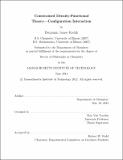Constrained Density-Functional Theory--Configuration Interaction
Author(s)
Kaduk, Benjamin James
DownloadFull printable version (2.877Mb)
Alternative title
Constrained DFT--Configuration Interaction
CDFT-CI
Other Contributors
Massachusetts Institute of Technology. Dept. of Chemistry.
Advisor
Troy Van Voorhis.
Terms of use
Metadata
Show full item recordAbstract
In this thesis, I implemented a method for performing electronic structure calculations, "Constrained Density Functional Theory-- Configuration Interaction" (CDFT-CI), which builds upon the computational strengths of Density Functional Theory and improves upon it by including higher level treatments of electronic correlation which are not readily available in Density-Functional Theory but are a keystone of wavefunction-based electronic structure methods. The method involves using CDFT to construct a small basis of hand-picked states which suffice to reasonably describe the static correlation present in a particular system, and efficiently computing electronic coupling elements between them. Analytical gradients were also implemented, involving computational effort roughly equivalent to the evaluation of an analytical Hessian for an ordinary DFT calculation. The routines were implemented within Q-Chem in a fashion accessible to end users; calculations were performed to assess how CDFT-CI improves reaction transition state energies, and to assess its ability to produce conical intersections, as compared to ordinary DFT. The analytical gradients enabled optimization of reaction transition-state structures, as well as geometry optimization on electronic excited states, with good results.
Description
Thesis (Ph. D.)--Massachusetts Institute of Technology, Dept. of Chemistry, 2012. This electronic version was submitted by the student author. The certified thesis is available in the Institute Archives and Special Collections. Cataloged from student-submitted PDF version of thesis. Includes bibliographical references (p. 117-136).
Date issued
2012Department
Massachusetts Institute of Technology. Department of ChemistryPublisher
Massachusetts Institute of Technology
Keywords
Chemistry.